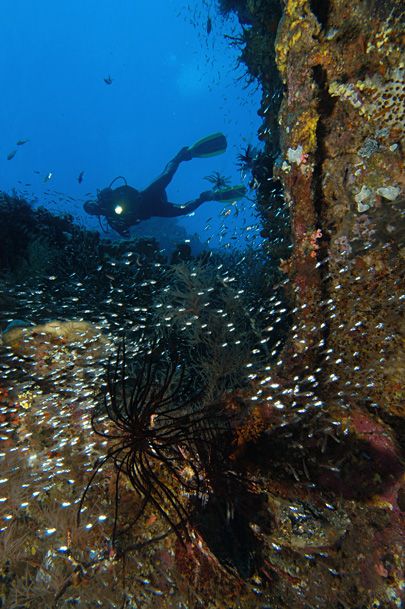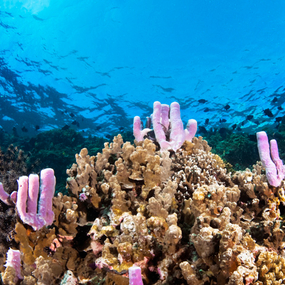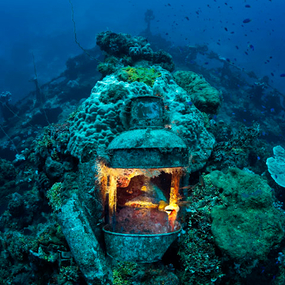Wide Angle Tips and Techniques
Shooting wide is both challenging and rewarding. You have learned that it requires attention to both the foreground and background and how the two work together to become a cohesive striking image. Here are some practical tips to get you going, or improve where you are now.
-
We’ll say it a million times - get close. Use as wide a lens as possible to get close to your subjects, limiting the amount of water between your camera and the subject.
-
 Pre-set your camera before entering the water, but take test shots of the blue water as you descend, adjusting settings for the light conditions. There is no right camera setting, only correct settings for any specific lighting conditions. For a sunny day jump in with your aperture set to f/8 or f/11 and shutter speed at 1/125 or 1/160. In the rare instance that the moment you jump in a rare pelagic happens to be right in front of you, you’ll at least have a fighting chance at capturing an image that is exposed well enough to process properly in Photoshop.
Pre-set your camera before entering the water, but take test shots of the blue water as you descend, adjusting settings for the light conditions. There is no right camera setting, only correct settings for any specific lighting conditions. For a sunny day jump in with your aperture set to f/8 or f/11 and shutter speed at 1/125 or 1/160. In the rare instance that the moment you jump in a rare pelagic happens to be right in front of you, you’ll at least have a fighting chance at capturing an image that is exposed well enough to process properly in Photoshop.
-
Shoot scenes both vertically and horizontally, you might find that the orientation you originally intended to shoot is not the best option. In all cases follow basic rules of composition (and feel free to break the rules once you have the hang of it). More on composition in our Composition Guide.
-
Create contrast to ensure that your wide angle images “pop” by shooting at an upward angle and keeping your subject against a different color background such that the foreground subject doesn’t merge into the background, a common mistake that results in cluttered and unappealing images.
-
Master lighting first by shooting immobile objects such as corals and sponges.

If you’re having trouble try this:
Turn off your strobes, create a proper exposure just of the blue water background, then turn your strobes back on at a mid or low power setting, in the “standard” wide angle strobe position and experiment with how much strobe power you need to properly expose and separate the foreground from the background. Hint: you may find that you rarely need to use your strobes at full power!
-
Experiment with strobe positioning. Don’t be afraid to move your strobes above or below the camera plane and if using multiple strobes, trying variations of angles and combinations.
-
Once you’ve mastered lighting, begin adding additional compositional elements to your images such as divers, which can add perspective to your scenes. Play with the positioning of your subjects against the negative space in the frame, which can make a big impact in the final image.
-
Train your eyes to look for good wide angle foreground subjects that can either be contrast with open water, or have back ground elements that will add to the composition in a unique way. The more you shoot and review your results, the more you will be able to identify opportunities that make great wide angle images.
Some additional composition ideas to try:
-
 Silhouette your subject against the background, this is easy to do and it’s a good way to practice getting good exposure of the blue water. It also doesn’t require a strobe. Read our tutorial on creating silhouettes.
Silhouette your subject against the background, this is easy to do and it’s a good way to practice getting good exposure of the blue water. It also doesn’t require a strobe. Read our tutorial on creating silhouettes.
-
Create a “forced perspective” by getting in as close as possible and creating an optical illusion that your subject is much larger than reality. Once you are in your groove you should experiment with this technique, which can produce unique results. Read our guide to Close Focus Wide Angle.
-
Try shooting split shots or “over-unders”, where the image is captured partially underwater and partially above the surface, which can only be accomplished with a large dome port. The large surface area of the dome breaks the plane of the water and allows for this unique technique. Split shots are some of the most difficult images to create, as you must compensate for the difference in ambient exposure above and below the water line. However, the challenge can yield equal rewards when you nail the shot. Read our special piece on creating over unders / split shots by legendary underwater photographer David Doubilet.
-
Shipwrecks present an entire array of opportunities and are unique subjects that relay mystery and context within the underwater environment. You can read our Guide to Shooting Shipwrecks in another special piece from David Doubilet.
-
One of the most challenging shots to strive for is an ultra-wide panoramic. This can only be accomplished in shallow water where you are relying heavily on ambient light and your strobes are only being used as fill light to fill in some detail in the shadows. You can create one ultra-wide image and crop it to have a panoramic dimension, or you can carefully move parallel to the reef shooting multiple exposures at the same settings and stitch them all together in post processing. The adventurous soul can also use the Hasselblad X-Pan – that is, if you can ever get your hands on a custom housing for it. The challenge is to accomplish this image with rich colors and detail. Add it to your list.

So what are you waiting for? Get out there and go wide!
Return back to Techniques Section
RELATED CONTENT
Be the first to add a comment to this article.
You must be logged in to comment.
Support Our Sponsors
Newsletter
Travel with us
Featured Photographer

Ron Steven
Expert Photographer
Rogest (Ron G Steven) Rogest\'s work has been in articles and portfolios and featured on the front covers of publication all over the world, he is an author (A fish In My Heart). An ardent supporter of the environment, Ron...
Follow Us
Sponsors





 Antarctica
Antarctica




